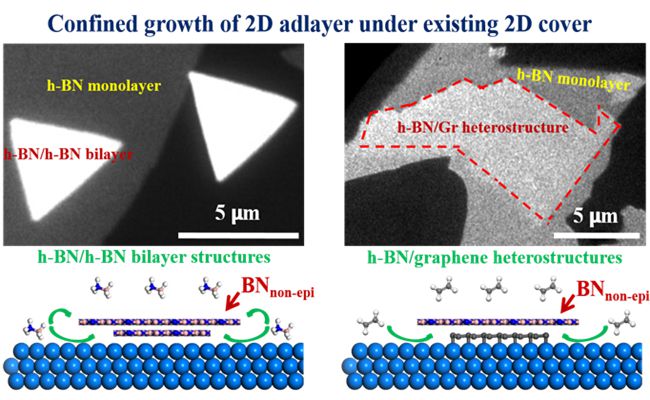Nano and interfacial research group in the State Key Laboratory of Catalysis (SKLC) has recently made a new progress in confined growth of two-dimensional (2D) atomic crystal heterostructures and in-situ dynamic surface characterization. These new results have been published in the recent issue of ACS Nano (2015, 9, 11589-11598, http://pubs.acs.org/doi/abs/10.1021/acsnano.5b05509).
2D atomic crystal heterostructures have attracted increasing attentions recently. However, the controlled construction of the heterostructures remains as a challenge. A team lead by Prof. Qiang Fu and Prof. Xinhe Bao makes use of the newly developed photoemission electron microscopy (PEEM)/low energy electron microscopy (LEEM) system in SKLC and other surface science instruments to study chemistry at the interfaces between 2D materials and solid surfaces. They found that the interface can be regarded as a nanosized reactor. Accordingly, a concept “Chemistry under Cover” has been developed illustrating the 2D confinement effect on surface chemistry (Angew Chem Int Ed 2012, 51, 4856; PNAS 2014, 111, 17023; Nano Lett 2015, 15, 3616). Guided by this concept, they have explored the growth of one kind of 2D atomic crystal under the cover of the other kind of 2D atomic crystal, and succeed in construction of 2D atomic crystal heterostructures. These results suggest that the vertical stacking of 2D atomic crystals can be achieved through the confined growth under the cover, which provides a new route towards the growth of heterostructures. In the same issue, editor has highlighted this work with “Room to grow beneath h-BN” (http://pubs.acs.org/doi/full/10.1021/acsnano.5b07283).

DICP Researchers Confine Growth of Two-Dimensional (2D) Atomic Crystal Heterostructures and In-situ Dynamic Surface Characterization (Photo by Ying SHI)
This work is supported by the Natural Science Foundation of China, the Ministry of Science and Technology, the Chinese Academy of Sciences, the Ministry of Finance, and the iChEM program. (By Ying Shi)